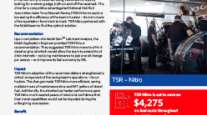Diesel Dips for Fifth Straight Week; Gas Falls as Midwest Prices Tumble
This story appears in the July 1 print edition of Transport Topics.
Retail diesel prices slipped 0.3 cent to $3.838 last week, the fifth straight drop, while the gasoline average fell almost a nickel as prices tumbled nearly 20 cents in the Midwest, the Department of Energy reported.
Diesel has declined 5.2 cents in the past five weeks. Last week’s decline left diesel 16 cents higher than the same week last year — but the lowest in almost a year, since it was $3.796 per gallon on July 30.
Regionally, diesel prices were mixed, climbing 1.3 cents in California to $4.035, while sliding 1.2 cents in the Midwest to $3.847, DOE said after its June 24 survey of fueling stations.
“Crude oil prices have been very flat the last month-and-a-half,” said Sean Hill, an analyst with DOE’s Energy Information Administration. “That’s translated to diesel retail prices remaining extremely steady. The only story with diesel has been no story.”
DOE also said regular retail gasoline dropped 4.9 cents to $3.577 a gallon, its second straight decline and the lowest retail price in seven weeks.
Gasoline, which is 14 cents higher than the same week last year, has been more active than diesel in recent weeks because of several refinery outages in the Midwest.
Most refineries have come back on line, and the gasoline average in EIA’s Midwest grouping of states plummeted 19.2 cents to $3.546 last week.
Midwest prices “are now falling closer to normal, helped by resumption of refining and the import of gasoline from other parts of the nation,” DOE said in a June 27 statement.
Hill noted gasoline fell by 27 cents a gallon in Ohio.
“I was truly amazed the other night when I went out and passed a gas station and it was $3.29 a gallon,” said Larry Davis, president of the Ohio Trucking Association. “I only needed eight or nine gallons to fill my tank, but I thought, ‘Oh my goodness, that’s worth turning around for and going back.’ ”
Even with pump prices falling, fleets continue to explore steps to reduce total expenses.
For example, Gary Ayers, vice president of Arlington Heavy Hauling, Jacksonville, Fla., said his company attempts to cut fuel costs by discount deals at truck stops and offering incentives to drivers who watch their idling and speed.
“We reward our drivers with an extra 2 cents a mile if they meet certain parameters on idling and speed — the only two things I monitor on the trucks,” Ayers said.
Arlington Heavy Hauling measures the percentage of time a driver is idling or exceeds 66 mph, although the carrier’s 30 trucks are governed at 68 mph.
If they meet a certain score built into a spreadsheet formula, Arlington’s drivers can expect an additional $20 to $50 a week more in their paychecks, Ayers said.
“We pick those two items because our fleet is mixed,” Ayers added. “Some drivers pull heavier loads than others, and some run in different geographic areas.”
George Akerson, president of food grade equipment hauler Dahlsten Truck Line Inc., based in Clay Center, Neb., said his company uses auxiliary power units to reduce idling time by 3%, puts super single tires on all trucks, equips power units with aerodynamics and receives discounts with certain truck stops.
The company, which runs about 75 power units, offers fuel bonuses to reward good driver habits and governs its trucks at 65 mph.
Akerson said the carrier also special orders smooth-skinned pneumatic tankers with internal support rings to net better fuel economy.
Depending on wind conditions, the design of the tank boosts the company’s fuel economy by one-third to one-half a mile per gallon, Akerson said.
Also last week, crude oil on the New York Mercantile Exchange closed at $97.05 a barrel on June 27. Since May 1, closing prices have vacillated between $91.03 and $98.44.
Domestic oil production in the most recent week reached 7.26 million barrels, up 132,000 barrels from the prior week, and an increase of more than 1 million barrels over the same week last year, according to EIA data.
With U.S. crude oil production growing, the current trend is toward global supply outpacing global demand, which will bring crude prices down, EIA’s Hill said.
Looking ahead, Hill said diesel prices should remain relatively stable, dipping to $3.80 by the end of the year.
On the other hand, gasoline prices are expected to fall at year-end to as low as $3.30 a gallon because of lower demand and a switch to winter blends, Hill said.




